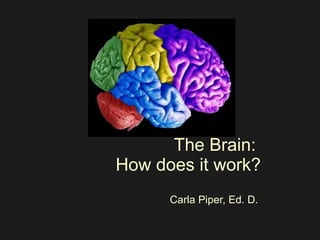More Related Content
What's hot
What's hot (20)
Dual credit psychology notes chapter 6 - brain and body

Dual credit psychology notes chapter 6 - brain and body
Similar to Brain533
Similar to Brain533 (20)
The Biological MindChapter 4Biological Psycholog.docx

The Biological MindChapter 4Biological Psycholog.docx
3. Behind the CurtainMusic and the Mind Machine12.docx

3. Behind the CurtainMusic and the Mind Machine12.docx
More from Carla Piper
More from Carla Piper (20)
Essential questions and enduring understandings of Visual Arts

Essential questions and enduring understandings of Visual Arts
Essential Questions and DOK Thinking Levels - EDSU 533

Essential Questions and DOK Thinking Levels - EDSU 533
Brain533
- 1. The Brain: How does it work? Carla Piper, Ed. D.
- 9. Brain Activity by Age Stages of Development Through Sensory Experiences in the First Year
- 19. Memory The Brain from Top to Bottom Stimulus Sensory Organs Sensory Memory Millisecond to Second Short-Term Working Memory Less than a minute Long-Term Memory Days, Months, Years Perception Attention Forgetting Repetition
- 20. The Five Senses Seeing, Hearing, and Smelling the World "Everything we know about the world comes to us through our senses. Traditionally, we were thought to have just five of them— sight , hearing , touch , smell , and taste . Scientists now recognize that we have several additional kinds of sensations, such as pain, pressure, temperature, joint position, muscle sense, and movement, but these are generally included under "touch." (The brain areas involved are called the "somatosensory" areas.)" Howard Hughes Medical Center http://www.hhmi.org/senses/
- 21. Long Term Memory Long Term Memory Implicit Explicit Emotional Conditioning Procedural Skills Episodic Autobiographical Events Semantic Words, Ideas Concepts Declarative Non-Declarative Priming Conditioned Reflex Unconscious Association
- 23. Language and Images of the Mind
- 31. Auditory , Kinesthetic , Visual

